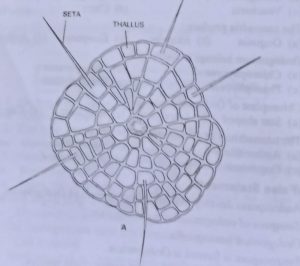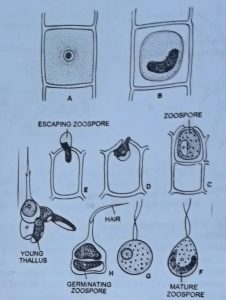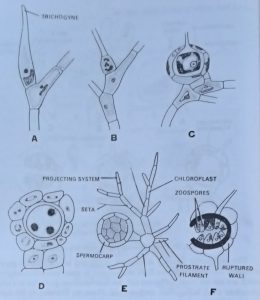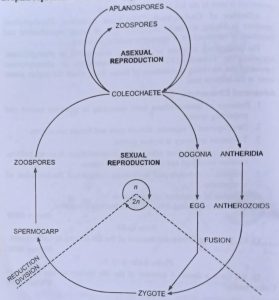Q.5. Describe briefly the life history of Coleochaete.
Ans.5. Coleochaete is a small fresh water green algae, usually occurs epiphytically upon several aquatic plants. Some species also grow endophytically inside the wall of Charales. The common Indian species is C. orbicularlies.
Structure
The plant body of coleochaete is typically heterotriclous i.e., consists of a prostrate and a erect system. In case of c. pulvinata the plant body is heterotrichous, with a prostrate anchored portion and an erect portion of branched filaments so arranged as to form hemispherical cushion and commonly known as Cushioned forms. In another species e.g., C. scutata the portion is suppressed altogether and the prostrate branched filaments are laterally opposed to form a single layered circular disc with radiating row of cells. These commonly are known as prostrate forms or discoid forms.

Magnified structure of scutataEach cell of the filament, in both the forms, is enclosed by this cell wall and uninucleate with a single parietal or laminate chloroplast. Pyrenoid may be one or more and are embedded in the irregular chloroplast. Some of the cells bear hair like outgrowth, cytoplasmic state, each with a sheath at it base.
This is autotrophic plant.
Reproduction: Reproduction in this plant may take place either by asexual or sexual means.
- Asexual reproduction
(a) By Zoospores: The zoospore, which are uninucleate, ovoid and biflagellate structures usually produced in the terminal cells of the plants. Form a single cell (Zoospore mother cell) a single zoospore is formed. The zoospore liberates through a round pore formed at the apex of a short papilla of the parent cell. The zoospores swim for an hour approximately and the rest. The cilia are withdrawn and the protoplast of each zoospore becomes rounded and secretes a wall around it. The protoplast of this one called germiling divides again and a multicellular thalloid structure is developed.

(b) By Aplanospore: Sometimes during the unfavourable periods the cytoplasmic contents of any vegetative cell form a large thick walled oval aplanospore intested of zoospore. These germinate to give rise to a new plant.
Sexual Reproduction
This is of oogamous type. The plants may be monoecious or dioecious. The male sex organs are called antheridia and the female sex organs as oogonia or carpogonia.

The antheridia develop in clusters at the end of the vertical growing branches. The antheridia are flask shaped arise as small colourless outgrowth which are cut off from the parent cell. Each antheridium gives rise to a single, colourless oval, biflagellate antherozoid. These are liberated by the rupture of antheridium apex.
The oogonium develops terminally on short lateral branch of vertical filament but, however, this may be used to a lateral position. Oogonium is flask shaped, having a basal swollen part containing nucleus and cytoplasm and an elongated neck the trichogyne. (BSc Botany Chlorophyta Sample Practice Question Answers)
Fertilization and germination of zygote
The antherozoids get liberated free, they come around the oogonium and passes down to the oosphere (female nucleus) through trichogyne. The male nucleus fuses with female nucleus and results in the formation of zygote. After fertilization the trichogyne degenerate and the oogonium increases in size. Around the zygote or zoospore a thick and brown wall is laid down. The vegetative cell below the oogonium grow upward and from a parenchymatous cover soon becomes reddish and is known as spermocarp or fruiting body.

After undergoing a period of test the zygote germinates. The zygote nucleus first divides by reduction division and then by simple divisions to form 8 to 32 daughter nuclei. Each nuclear division is followed by cytokinesis. Finally each daughter protoplast metamorphoses into a biflagellate zoospores. The zoospores are liberated by the breaking of the spermocarpic wall and then develop (directly into new thalli like zoospores of sexual reproduction).
Life Cycle
Coleochaete exhibits haplontic life cycle. The plant body is haploid and represents the gametophytic generation. During sexual reproduction produces antheridia and oogonia. Diploid zygote is formed after fertilization. As a result of post fertilization changes spermocarp develops. It acts as sporophytic generation. It produces haploid zoospores after reduction division. The zoospores grow into new plants thus an alternation of ration is seen in the life cycle of Coleochaete.

Affinities of Choleochaete- Coleochaete resembles Rhodophycean members in having advanced oogamous type of sexual reproduction and formation of spermocarps. It represents parallel evolution.
The occurrence of setae or bristles is comparable to phaeophyceae. According to Fritsch (1935) the Chaetophorales of chlorophyceae represents the surviving descendants of forms from which the higher plants arose in the remove past.
Advanced Characters
- Presence of heterotrichous habit consisting of prostrate system and projecting system.
- Development of separate, distinct male and female sex organs.
- Terrestrial tendency in certain genera.
- The oogonium is most advanced in the green algae. It shows bulbous swollen basal part and a neck called trichogyne.
- Presence of elaborate post fertilization changes and the formation of spermocarp.
- Presence of alternation of generations.
Feature of special interest in Coleochaete
(i) The plant body is typically heterotrichous, consisting of prostrate branches and erect branches (cushioned forms). In C. scutatta (discoid form) however, the erect branches are suppressed which results in the formation of psedoparenchymatous mass contain cytoplasmic setae.
(ii) The sexual reproduction is oogamous. The oogania are flask shaped structured and develop a long neck.
(iii) The zygote become surrounded by sterile basal filaments and forms the spermocarp.
The development of spermocarp is again a feature of advance which is found in higher classes of algae like Rhodophyceae.
BSc 1st Year Botany Chlorophyta Sample Model Practice Question Answer Papers